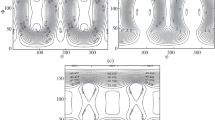Within the framework of the available theories, the initiation of plastic shear and nucleation cracks in perfect crystals is possible only at a deforming stress close to the theoretical strength. It is shown that a perfect crystal, treated as an open system of nuclei and electrons, loses its stability at applied stresses that are orders of magnitude smaller than the theoretical strength. This helps avoiding the use of the concept of various types of defects present in the bulk and in the surface layer of the crystal. The physical reason for the instability is the excitation of dynamic displacements determined by nonadiabatic transitions of Landau-Zener atoms between the intersecting potential energy surfaces in open nonequilibrium systems. A qualitative explanation of the experimentally observed results is given.
Similar content being viewed by others
References
A. D. Korotaev, Elements of the Dislocation Theory [in Russian], NTL Publ., Tomsk (2020).
M. Born and K. Huang, Dynamical Theory of Crystal Lattices, Oxford University Press (1954).
A. A. Griffith, Philos. Trans. R. Soc. London, 221, 163 (1921).
S. A. Sokolov and D. E. Tulin, Phys. Mesomech. 25, 72 (2022).
M. A. Kozhevnikova, Zh. Fizich. Mezomekh., 24(2), 93 (2021).
Y. Jin, Y. Wang, and A. Khachaturyan, Appl. Phys. Lett., 79, 3071 (2001).
S. N. Zhurkov, V. E. Korsukov, and A. S. Luk'yanenko, et al., JETP Lett., 51, 370 (1990).
A. M. Davydov, Quantum Mechanics [in Russian], Nauka, Moscow (1973).
V. L. Indenbom, Physics of Crystals with Defects, Volume I [in Russian], Tbilisi (1966).
P. Hohenberg and W. Kohn, Phys.Rev., 136, B864 (1964).
J. C. Tully, J. Chem. Phys., 137, 22A301 (2012).
M. Von Born and R. Oppenheimer, Ann. Phys., 84, No. 20, 457 (1927).
S. G. Psakhie, K. P. Zolnikov, D. S. Kryzhevich, and A. G. Lipnitskii, Phys. Lett., A 349, 509 (2006).
D. Rodney and L. Proville, Phys. Rev., B79, 094108 (2009).
L. Landau, Phys. Z. Sowjetunion, 2, 46 (1932).
C. Zener, Proc. R. Soc., A 137, 696 (1932).
V. E. Egorushkin and N. V. Mel'nikova, JETP, 1, 103 (1993).
C. Zhu and H. Nakamura, J. Chem. Phys., 101, 10630 (1994).
C. Zhu and H. Nakamura, J. Chem. Phys., 102, 7448 (1995).
L. Yue, L. Yu, C. Xu, et al., Chem. Phys. Chem, 18(10), 1274 (2017), DOI:https://doi.org/10.1002/cphc.201700049.
R. Kapral, J. Phys.: Condens. Matter, 27, 073201 (2015).
L. B. Zuev and Yu. A. Khon, Phys. Mesomech., 25, 1103 (2022).
Yu. A. Khon and L. B. Zuev, Zh. Fizich. Mezomekh., 25, 111 (2022).
Yu. A. Khon, Russ. Phys. J., 64, No. 4, 612 (2021).
Yu. A. Khon, Russ. Phys. J., 65, No. 3, 545 (2022).
Author information
Authors and Affiliations
Corresponding author
Additional information
Translated from Izvestiya Vysshikh Uchebnykh Zavedenii, Fizika, No. 8, pp. 76–80, August, 2022.
Rights and permissions
Springer Nature or its licensor (e.g. a society or other partner) holds exclusive rights to this article under a publishing agreement with the author(s) or other rightsholder(s); author self-archiving of the accepted manuscript version of this article is solely governed by the terms of such publishing agreement and applicable law.
About this article
Cite this article
Khon, Y.A. Theoretical and Real Strength of Crystals: Physical Reason for the Difference. Russ Phys J 65, 1318–1322 (2022). https://doi.org/10.1007/s11182-023-02768-9
Received:
Published:
Issue Date:
DOI: https://doi.org/10.1007/s11182-023-02768-9



